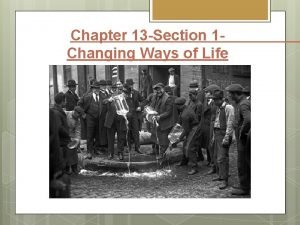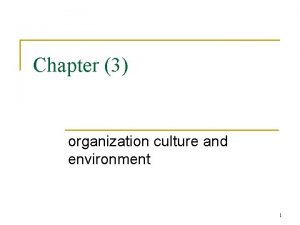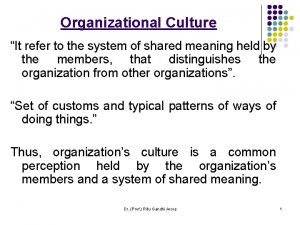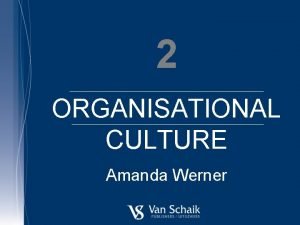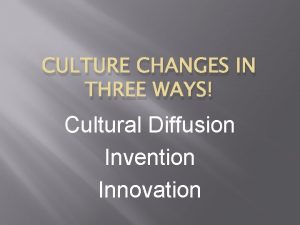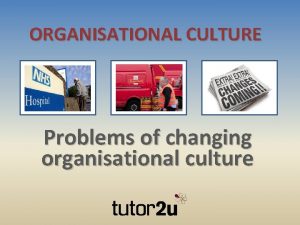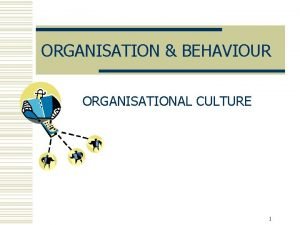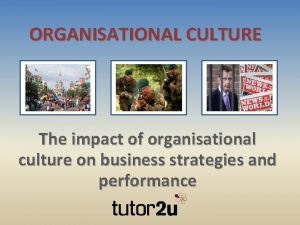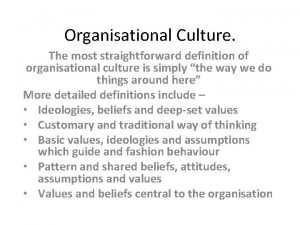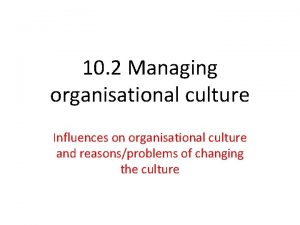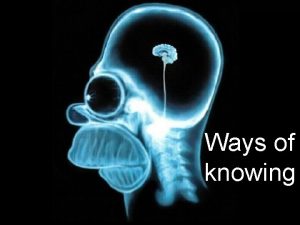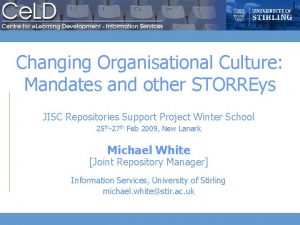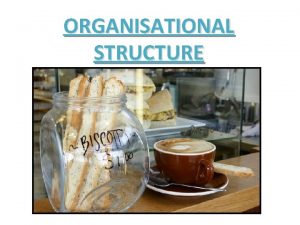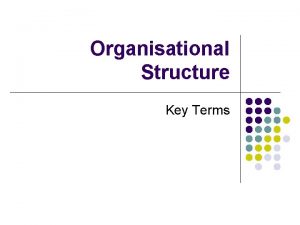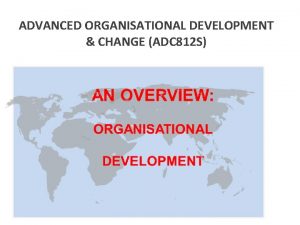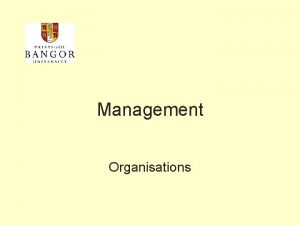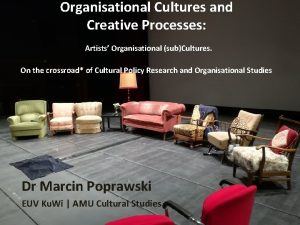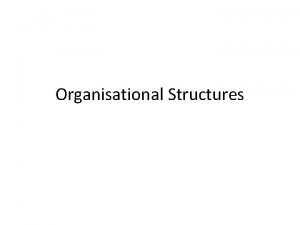ORGANISATIONAL CULTURE Ways of changing organisational culture What




















- Slides: 20

ORGANISATIONAL CULTURE Ways of changing organisational culture

What is change management? A structured approach in an organisation for ensuring that changes are smoothly and successfully implemented, and that the lasting benefits of change are achieved.

Four elements to change Change is the result of dissatisfaction with present strategies Essential to develop a vision for a better alternative Necessary to develop strategies to implement change There will be resistance to change

Two types of change Step change Occurs rapidly Incremental change Change occurs over a period of time in incremental stages

Step v incremental change • Step change – Dramatic or radical change in one fell swoop – Radical alteration in the business – Gets it over with quickly – May require some coercion • Incremental change – Ongoing piecemeal change which takes place as part of an organisation’s evolution and development – Tends to more inclusive

Barclays’ new CEO is opting to go for step change in culture…

Analysing whether change is possible Lewin Force field Analysis In Lewin’s model there are forces driving change and forces restraining it. Where there is equilibrium between the two sets of forces there will be no change. In order for change to occur the driving force must exceed the restraining force

Lewin’s Force Field Analysis Forcefield analysis provides an overview of the change problems that need to be tackled by a business, Kurt Lewin splitting factors into forces for and against change

Lewin’s Force Field Model Forces for change Driving forces Forces resisting change Restraining forces

Forcefield analysis • There are forces driving change and forces restraining it • Where there is an equilibrium between the two sets of forces there will be no change • In order for change to occur the driving force must exceed the restraining force • The analysis can be used to: – – Investigate the balance of power involved in an issue Identify the key stakeholders on the issue Identify opponents and allies Identify how to influence the target groups

Forces for change Internal forces External forces • Desire to increase profitability • Reorganisation to increase efficiency • Conflict between departments • To change organisational culture • • Customer demand Competition Cost of inputs Legislation & taxes Political Ethics & social values Technological change

A good example – Royal Mail Technological & social change (email, social media) Large workforce – many with long service Preparing for privatisation Heavily unionised & record of industrial disputes New CEO = new leadership Providing postal services is highly complex Greater competition from deregulation (e. g. DHL, TNT) Finance – heavy losses and negative cash flow

Techniques to help implement change • • • Cross-functional teams Stronger internal communication Negotiation Action planning Change agents or champions of change And a certain amount of compulsion manipulation and coercion

Helping people to accept change • Act decisively – demonstrate momentum • Consider how they will be affected • Involve them in the change • Consult and inform frequently • Be firm but flexible • Monitor the change

Insights from CEOs on how to manage culture change (1) Moya Greene (Royal Mail): on the need to bring in new people: “If you have the right people, you can overcome organisational problems. But if you do not have the right people, an organisation that is brilliant is not going to get you there”.

Insights from CEOs on how to manage culture change (2) Archie Norman (ITV, Asda): “Understand the DNA of the company and what— culturally—led it to be in a failed situation. Behind all financial failures is organizational failure.

Insights from CEOs on how to manage culture change (3) Irene Rosenfeld (Kraft Foods): on the need to drive culture change quickly: “I think anybody who has been involved in a transformation typically wishes he or she had gone faster. You have to move quickly to have all the pieces come together. ”

Key depends on factors • Lots of evidence that culture management is not optional – so leaders have to find a way! • Ed Schein: "if you do not manage culture, it will manage you" • Organisational culture is a "soft" management issue it is not easily measured or controlled - but it is a mistake therefore not to take it seriously. • Organisational culture is becoming less predictable like other elements of the external environment because of the way that work is changing. • Schein: culture is a group phenomenon

Some possible evaluation points • It is too easy to under-estimate the challenge of trying to change/improve organisational culture. • Culture change is not straightforward. It is a slow and often painful process. • You cannot “create” a new culture in an organisation that has already evolved a culture.

Visit the tutor 2 u BUSS 4 Organisational Culture Blog for more resources
 Organisational culture tutor2u
Organisational culture tutor2u The roaring twenties lesson 3 changing ways of life
The roaring twenties lesson 3 changing ways of life Chapter 13 section 1 guided reading changing ways of life
Chapter 13 section 1 guided reading changing ways of life Chapter 21 section 1 changing ways of life
Chapter 21 section 1 changing ways of life Romans 3:10
Romans 3:10 Strong and weak organisational culture
Strong and weak organisational culture Wesfarmers organisational structure
Wesfarmers organisational structure What is organisational culture
What is organisational culture Purpose of organisational culture
Purpose of organisational culture Quality culture
Quality culture 3 ways culture changes
3 ways culture changes Batch culture vs continuous culture
Batch culture vs continuous culture Robertson cooked meat medium
Robertson cooked meat medium Folk culture and popular culture venn diagram
Folk culture and popular culture venn diagram Folk culture and popular culture venn diagram
Folk culture and popular culture venn diagram Individualistic culture vs. collectivist culture
Individualistic culture vs. collectivist culture Fed-batch
Fed-batch Surface culture deep culture and esol
Surface culture deep culture and esol Sub culture vs counter culture
Sub culture vs counter culture Material culture examples
Material culture examples Adaptive culture from inert culture
Adaptive culture from inert culture


